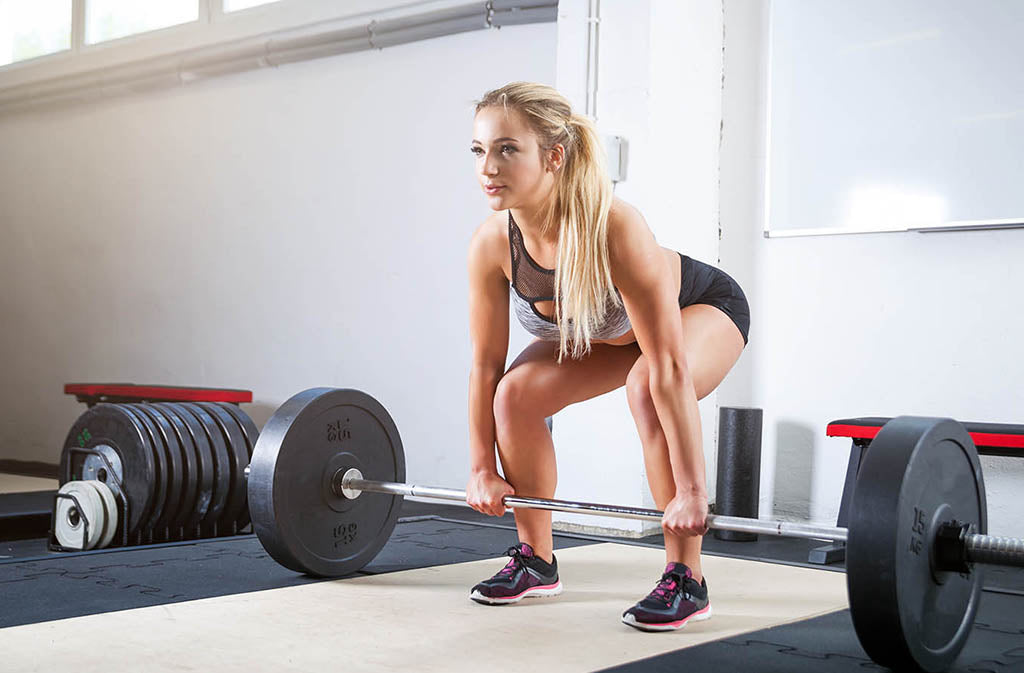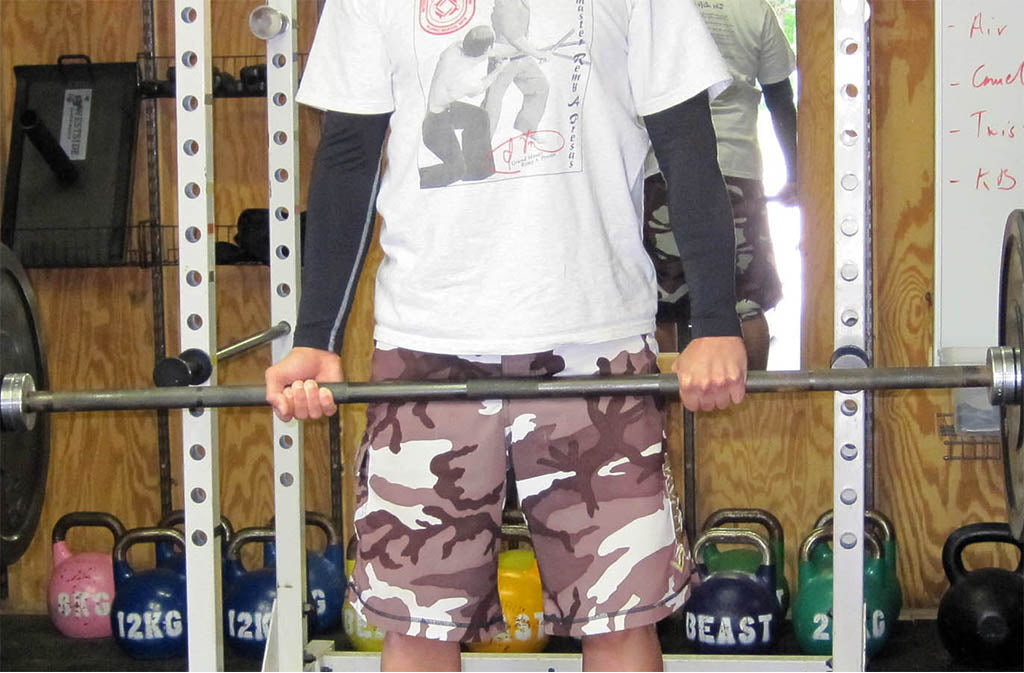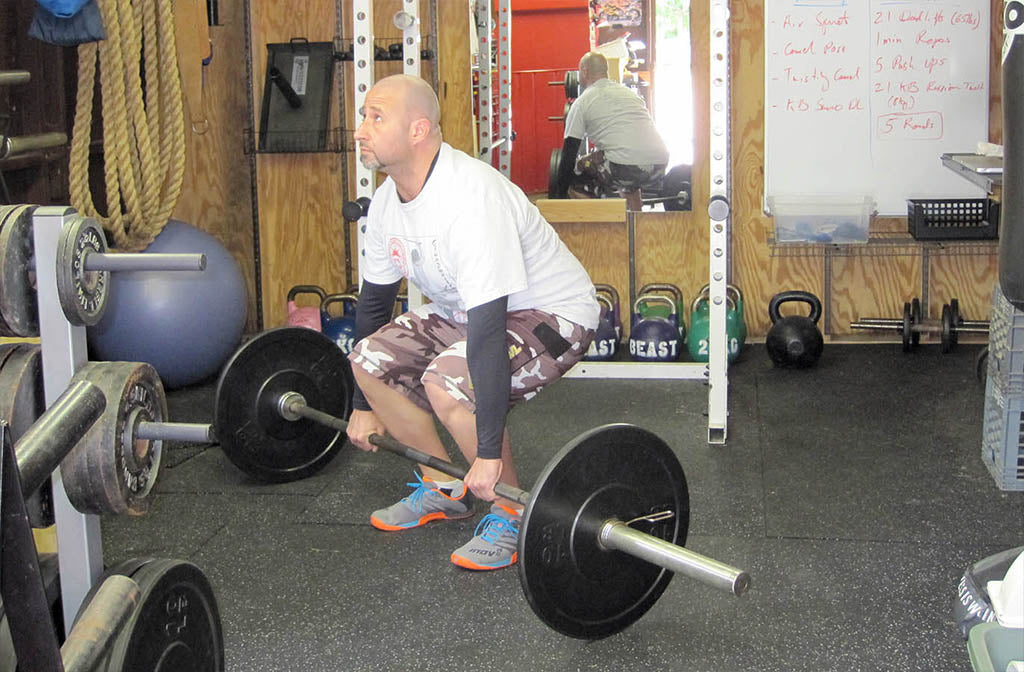How to Deadlift: The Ultimate Guide - Part 1
This is a guest blog post by Adam Farrah, author of The Paleo Dieter’s Missing Link and Functional Fitness, Kettlebell, Yoga and Meditation coach.

The deadlift is a foundational, multi-joint exercise that involves picking up a heavy object—most often a weighted barbell—from the floor with the arms extended throughout. It involves virtually every muscle in the body and has a well-deserved reputation for building muscle—both directly through adaptation to the exercise and indirectly through overall stimulation of the body’s anabolic hormone production.
In this two-part series on the deadlift, you will learn:
- Why the deadlift is an important exercise
- How to deadlift safely and effectively
- Where deadlift form tends to go wrong, and how to correct it
- Deadlift modifications and variations
- How to incorporate the deadlift into an effective and challenging workout
Ready to Go Beyond with your deadlift? Let’s go!
The “Perfect” Deadlift
A well-executed deadlift starts with the lifter’s hips low, head up, back flat, and arms straight. The upper back contracts against the weight, removing any slack from the rotating mechanism of the bar. The feet then push into the floor as the lifter creates a feeling of driving them “through” the floor. As the weight breaks free of the ground, the legs contract, accelerating the weight’s movement. When the bar reaches the knees, the hips begin to rise faster and drive forward, and the entire posterior chain engages to bring the body to standing.
Sounds easy, right?
Wrong!
The deadlift is both simple and complex in execution. At its simplest, it’s simply picking a loaded barbell up off the floor. The devil is in the details, though, and when executed well, the deadlift is a technical exercise full of nuances.
Before we go further on deadlifting technique, however, let’s cover why you should be deadlifting in the first place.
Shop Now!Picking Up a Heavy Object from the Ground: A Fundamental Human Movement
Nearly 10 years ago in a lecture on CrossFit methodology, CrossFit founder Greg Glassman recalled a “discussion” he’d had with a physician about whether or not the deadlift was safe and necessary for virtually every trainee in one form or another. The physician argued that someone like an elderly woman shouldn’t be taught to deadlift.
Glassman then asked: “What if this same woman carried a bag of food for her cat from the car to the front door and put the bag down to get her keys and open the door? Would she be medically cleared to pick the bag of cat food back up?”
The physician replied that, of course, she would be medically cleared to perform such an activity, as long as there were no preexisting injuries or specific limitations.
To this, Glassman replied: “So, the only difference is that I’m suggesting she be trained and instructed to perform that activity safely and correctly, and you’re suggesting she shouldn’t…”
It’s classic Glassman and early CrossFit theory, and it’s absolutely on point. One way or another, all of us pick something up off the ground daily.
Like the doctor in the story above, not everybody condones our desire to “lift things up and put them down,” but the fact remains that the deadlift is an absolutely foundational movement within our lives—and it deserves a central place in our training.
The “Cornerstone” Lift
Most of the training programs I create for clients have the deadlift as a prominent, central movement. It’s a cornerstone.Many Advanced Movements Start with a Deadlift
One of the greatest coaching epiphanies I’ve ever had was the realization that any movement that begins with a loaded barbell on the floor is initiated with something resembling a deadlift. Even a kettlebell swing starts with something like a sumo deadlift of the kettlebell off the floor.
With this realization, I developed a coaching progression for my clients that incorporated deadlift competency very early on in their training.
As an example, a barbell clean begins with the safe lifting of the barbell off the floor. And, many exercises begin by cleaning a barbell safely and effectively into a strong front rack—ones like barbell thrusters, barbell front squats, clean and jerks, etc.
That’s not to say that there isn’t more to a clean than a deadlift—there most certainly is—but I’ve found that ensuring a trainee has a strong deadlift first creates the confidence, the back-protective form, and the lifting habits needed to move into more advanced barbell movements safely.
It’s Anabolic
According to author and natural bodybuilding guru Stuart McRobert, the barbell deadlift is a major contributor to overall muscle and strength development due to its profound influence on the body’s endogenous anabolic hormone production. As with the barbell squat, the massive amount of musculature activated by the deadlift—virtually every muscle to one degree or another—signals the body to initiate a hormonal cascade that has significant systemic anabolic and fat-burning effects.
For these reasons alone, the deadlift deserves a central place in your weight training programming—so here’s what you need to know to do it right.
Safety Alert!
Deadlifting sometimes gets bad press in the mainstream. This is mainly due to the fact that too many trainees try to go too heavy, too soon in training and without a strong foundation of safe and effective form. Preexisting injuries aside, the deadlift can actually support back health by helping to develop a degree of protection and resilience into the lower back musculature.
With that out of the way, let’s break this movement down.
Deconstructing the Deadlift
Hand Position
Hand position depends on the type of lifting activity a trainee is interested in and the rules related to any events they intend to participate in.
Conventional or Double-Pronated Grip
I generally use a double-pronated grip for deadlifting and don’t use straps for general training and workouts.

Above is a conventional, straight or double-pronated grip in the deadlift.
Mixed Grip
A mixed grip—one hand pronated (palm facing the body in the deadlift) and the other supinated (palm away from the body in the deadlift)—is useful when straps either aren’t allowed or a workout is “on the clock” and the extra time to strap up isn’t desirable. This mixed grip is also good for near-max weights in training.
Some authors recommend switching the “mix” on the grip to avoid muscle imbalances. This is probably good advice, but I find that I’m stronger with my right supinated and my left pronated. Everyone seems to have one side that feels more natural than the other. Because we’re mixing the grip in pursuit of max weight, I generally just mix it to the strongest side and leave it at that.

Above is a mixed deadlift grip.
Straps
For general training, I think straps remove some of the “functional” aspect of training in general and deadlifting in particular. They’re great for handling the max weight and are absolutely essential to use in training if powerlifting competition is the goal and straps are allowed by the rules. But for average trainees, working poundages should be increasing more or less proportionally with grip strength, anyway. Plus, straps add complexity to training and can weaken the grip and forearms if relied upon too heavily.
Foot and Shin Position
If you stand up straight and relaxed, your arms naturally fall to your sides. The feet are “inside” the arms. This is more or less the position at the top of the deadlift and the foot position for the entire movement. On a standard Olympic bar, this is the position just inside the knurling for most people.
Removing the “Slack” from the Bar
One of the best coaching cues I know to prevent a trainee from “snatching” at the bar and initiating the lift with a vulnerable back is to enforce the removal of the slack from the bar before the lift starts.
If you gently pull up on a loaded barbell on the floor, you’ll find that there’s a slight bit of movement in the bar before it contacts the bearings in the ends and actually connects to the weight. This is the “slack” I’m referring to.
The trainee positions his feet, grips the bar, and then contracts the back until the millimeter or two of “slack” that’s in the bearings of the barbell is taken up. Removing that little bit of travel in the bar both reminds the trainee to contract the back before beginning the movement and also enforces a strong “squeeze” off the floor.
Feet and Footwear
Because the feet support the entire body throughout the deadlift, and the deadlift tends to be a heavier exercise with regard to training poundages, the feet and footwear deserve some attention too.
The feet are a small area of contact with the floor relative to the poundages the deadlift can commonly employ. For this reason, it’s possible for the feet to feel sore after an intensive deadlifting session. Progressing with poundage slowly and methodically is important so the feet can adapt. It’s also good to give the feet some focused attention with a foam roller or lacrosse ball as part of your total stretching and bodywork regimen after deadlifting. (You do have a regular body care regimen, right?)
As far as footwear, it’s common for advanced deadlifters and those with a Paleo or primal influence to deadlift barefoot. The main rationale here is that there is no loss in transmitting force from the body to the floor—no “leakage” of energy caused by a squishy shoe sole.
While no one should wear a heavily cushioned shoe for deadlifting due to lack of stability and massive power loss due to the padding, a minimalist shoe with slight cushioning can give novice deadlifters or those with sensitive feet some level of protection without sacrificing stability.
While deadlifting barefoot is the “best” way in terms of biomechanical efficiency and Paleo doctrine, work toward that goal slowly if you’re a novice and pay attention to what your body is telling you.
Back Flat
The first major form cue I address in deadlifting is keeping the back flat. Some rounding of the back can happen during max-effort lifts, but these are at the limit and form can break down slightly here when really pushing the exercise with big weight.
In training, I strive for perfection in form and technique so that the right foundation is in place. Once we know the rules, we can break them on occasion in pursuit of new personal records.
A flat back means that the back muscles are contracted against the weight. The purpose of the upper back muscles is to “pull toward” using the arms as attachment points. In flattening the back, we’re creating an isometric contraction against the weight that engages the back muscles, protects the spine, and stabilizes the entire exercise. A flat lower back means that the spinal erectors and other stabilizing core muscles are engaged.
A rounded back in a deadlift generally implies that the trainee either doesn’t know how to properly engage the back muscles for a deadlift or that the weight is just too heavy. In either case, the solution is to reduce the weight and focus on form first.

Above is the INCORRECT, back-rounded posture at the start of the movement.

Above is the CORRECT, flat-back deadlift starting position with the back contracted against the weight.
Head Up
Looking toward the horizon will naturally bring the neck to a neutral position. Dropping the chin and looking down during a deadlift encourages the back to round. Not good. Note the head position in the two pics above for examples of the head-down and head-up postures, respectively.
Sit Back and Pry the Knees
I always begin deadlift instruction with basic air squat instruction. If a trainee can’t squat properly, she can’t deadlift properly. I think of the deadlift as a “squat” with the weight connected to the body by the hands as opposed to supported by the torso. The barbell squat and the barbell deadlift share about 80% of the body mechanics with each other, so air squat instruction and proficiency always precedes deadlifting with my clients.
Unless your squat is picture perfect, at this point I’d strongly suggest reviewing my previous article, How to Squat: The Ultimate Guide.
And if your squat is already awesome, then…
Keep Reading for More Deadlifting Tips and Tricks
Check out Part 2 of Natural Force’s How to Deadlift: The Ultimate Guide for tips on troubleshooting deadlift form, variations of this important lift, and example workouts!
(Want to get posts like this by email? Here's the sign up)

